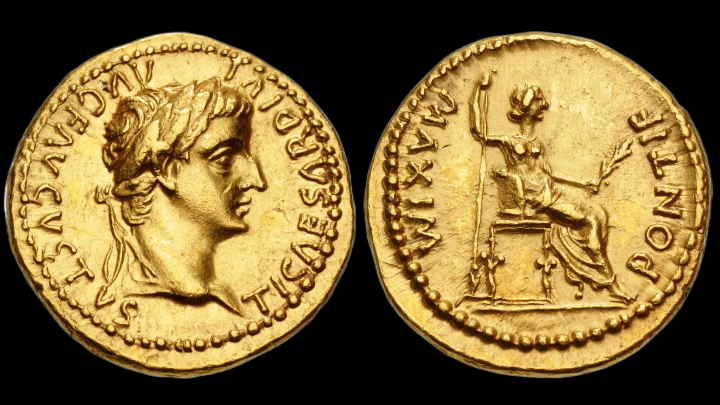Some coins transcend centuries, not only for their beauty or rarity, but also for the symbolic and historical weight they carry. The aureus of Tiberius, struck in AD 18 at Lugdunum (modern-day Lyon), is one of these emblematic pieces. Commonly referred to as the “Tribute Penny,” the denarius version of this coin is traditionally believed to be the one shown by Christ during the Gospel episode of “Render unto Caesar.”
Beyond its religious significance, this aureus embodies the imperial power of Rome under Tiberius, the successor of Augustus. Its clean design, rarity, and association with the biblical narrative make it an essential coin for collectors of imperial or spiritually significant numismatics.
The Coin: Simplicity and Strength in Imperial Gold
This is a gold aureus, measuring 19.5 mm in diameter and weighing 7.78 grams, minted at Lugdunum, one of the Empire’s main mints at the time. This specimen is graded Good VF, showing some edge marks and visible scratches, but retaining a high level of detail.
The obverse features a laureate portrait of Emperor Tiberius facing right, with the legend: "TI CΛESΛR DIVI ΛVG F ΛVGVSTVS"
which translates as: "Tiberius Caesar, son of the divine Augustus, Augustus." This inscription emphasizes Tiberius’s divine lineage and his official status as imperial successor.
The reverse depicts Livia, mother of Tiberius and widow of Augustus, seated right in the guise of Pax, the goddess of Peace. She holds an olive branch in her right hand and a reversed spear (or scepter) in her left. The throne features decorative legs set upon three horizontal lines. The legend "PONTIF MΛXIM" recalls that Tiberius also served as Pontifex Maximus, the head of the Roman state religion.
The composition delivers a clear message of peace, religious authority, and stability, in an empire pacified and unified under imperial rule.
 Source : CNG
Source : CNGThe History: Tiberius, Successor of Augustus and Architect of Continuity
Born in 42 BC, Tiberius ascended to the imperial throne upon the death of Augustus in AD 14. As the designated heir and adopted son of Rome’s first emperor, Tiberius ruled until his own death in AD 37. While his reign is often viewed as cold or reclusive, it was, in truth, marked by remarkable administrative stability and a strict adherence to the institutions established by Augustus.
The portrayal of Livia as Pax was a deliberate political choice — part of a dynastic legitimization strategy. This coin thus becomes a powerful political tool, emphasizing continuity, divine heritage, and the promise of peace offered by Roman rule.
Furthermore, the denarius (the silver counterpart of this aureus) is frequently associated with the “Tribute Penny” mentioned in the Gospel of Mark (12:17), in which Christ says, “Render unto Caesar the things that are Caesar’s.” Though this connection remains debated, it has greatly contributed to the coin’s fame in the Christian world.
A Cultural Symbol
The aureus of Tiberius, known as the “Tribute Penny,” is a coin of major historical, political, and symbolic importance. It represents imperial authority, divine lineage, and, for many, a direct link to biblical history.
This exceptional coin was sold for $13,000.
If you are looking for this coin, ask us — and we will find it for you.